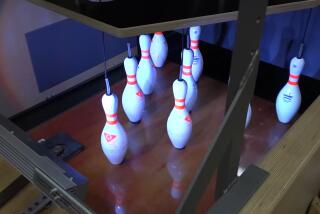The Gutter Ball of Progress Claims a Confirmed Kegler
- Share via
When you automate life you steal something from yourself. You steal the intellectual muscles that grow when you have to do the grunt work that precedes accomplishment. The “donkey work,” a friend calls it. We’ve been brilliant at eliminating donkey work. The kids who work at McDonald’s don’t have to add or subtract, just punch the right symbols. The kids who hang out in video game parlors can beat up mythical enemies without ever learning how to box. And nobody has to drill themselves in spelling any more as long as there’s a spell-check program on the computer software. Mastery is cheapened.
I was reminded of this Saturday at the bowling alley.
I’d gone to roll a couple of games for fun. Nothing organized. I wasn’t thinking big thoughts. I didn’t care, for example, that almost all bowling alleys have had automatic electronic scoreboards above each lane for more than a decade. I saw no sinister implications, since every bowling alley I’d been to always gave me a paper score sheet. They had to: It showed the reading of the meter that tracks the number of frames you bowl, so they’d know what to charge when you finished playing.
The score sheet had become one of those tiny anchors in my life: Bowling alleys have changed the surface of their lanes, they’ve changed the composition of their balls (which can cost $200 easy these days), but they haven’t changed the fact that if you use a paper score sheet, you will be forced to confront a disappearing intellectual skill, which in my school days was called practical math.
In a world that is addicted to mindless change, I took great pleasure in walking up to the counter of a bowling alley the same way I did as an adolescent and having the guy at the counter hand me a score sheet and bark out the number of the lane he’d assigned me. Let ‘em put all the fancy automatic scoring systems they want above the lanes, I figured; I’ll take my pencil and paper and do it manually.
And then came Saturday, when, for the first time, they took my pencil and paper away.
*
The sign taped to the counter of my Westside neighborhood bowling alley was incomprehensible:
No Practice Frames.
Pay in Advance.
No practice frame? Everybody takes a practice frame before they start to keep score. Sometimes you make it an optional practice frame: If you get a strike or spare, you count it. But to just start bowling cold is so . . . cold.
Equally confusing was the notion of paying in advance. How do I know how many games I want to bowl? Usually two, for me, but suppose I get a blister and want to quit? Suppose some mythic force pushes me over 160 in my second game and I want to bowl a third? There’s so little spontaneity left in life; must I choose before the dance?
Yeah, the guy behind the counter said sympathetically. You have to choose first. They’d upgraded their automated scoring system. They’d just introduced it a week and a half ago, and you could tell he wasn’t much happier about it than I was. He had to tell the computer how many games each person was signing up for, and every customer was irked about being robbed of their practice frame.
“Lane 17,” he told me, my daughter and my brother, another lifelong bowling junkie.
At this point, the guy behind the counter was supposed to hand me my score sheet.
He didn’t.
We don’t use ‘em anymore, he said. I would later learn that this latest changeover occurred years ago in many Southland bowling alleys, but this was my first taste of paperlessness.
Lead in my stomach, I walked to Lane 17.
*
The old scoring table, which had a small space to program the old automatic scoreboards, had been replaced by a table with no room to write, had they been nostalgic enough to let me have a score sheet. The new, tiny table was dominated by a triangular computer keyboard, with instructions on how to input each player’s name into the automatic scoring system. I was beginning to read them when my daughter pushed me aside and set the names up.
The game began. Not content to simply record each ball, the new system also flashed a diagram about how to pick up each particular spare. It flashed your name each time you got a strike. It warned you when you were approaching your prepaid limit. It left nothing to chance, or to the imagination.
It reminded me of what old-fashioned bowling had sparked in me that could never happen with this system. Bowling had made me fascinated with numbers as a kid.
When you have to do your own scoring, a funny thing happens. Not only do you have to learn how to add double- and triple-digit numbers, you become hooked on quantifying your performance. You become obsessed with your average. To compute an average, you have to learn how to multiply and divide.
Quick: I just shot a 728 for four games. What’d I average? No sweat: 182. How’d I do it? After a while, you memorize your 16 and your 17 and your 18 times tables because you’re measuring your scores against goals--i.e., if I want to average 180, I learn that three games of 180 is 540 and four games of 180 is 720. Every kid I bowled with in leagues when I was 14 could do this. You wanna know why I’ve never been overcharged by a restaurant cashier? Bowling.
And now it was gone.
No longer would I be able to badger my daughter, as she filled out the score sheet: While you’re writing your score down, honey, why dontcha figure out your average? No longer would I be able to show her the real-life value of math. No longer would I be able to marvel with her about how one field of endeavor strengthens another.
Now it will be only bowling for the sake of bowling.
Which allows me nothing more than this barren summation:
I beat her.
If only I had the score sheet to prove it.
More to Read
Go beyond the scoreboard
Get the latest on L.A.'s teams in the daily Sports Report newsletter.
You may occasionally receive promotional content from the Los Angeles Times.










